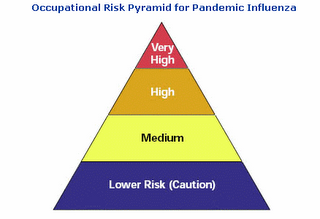# 421
OSHA (Occupational Safety & Health Administration) has released a set of recommendations for workplaces to reduce the effects of a pandemic. It is available as a PDF File here, or you may view the Web site here.
Written in plain language, this is more of a primer on how to reduce the spread of a pandemic virus in the workplace, than your typical OSHA document. Employees are divided into four categories, depending on their risk of exposure, and precautions for each are discussed, along with general steps to reduce virus transmission in a workplace.
Very High Exposure Risk:
High Exposure Risk:
- Healthcare employees (for example, doctors, nurses, dentists) performing aerosol-generating procedures on known or suspected pandemic patients (for example, cough induction procedures, bronchoscopies, some dental procedures, or invasive specimen collection).
- Healthcare or laboratory personnel collecting or handling specimens from known or suspected pandemic patients (for example, manipulating cultures from known or suspected pandemic influenza patients).
Medium Exposure Risk:
- Healthcare delivery and support staff exposed to known or suspected pandemic patients (for example, doctors, nurses, and other hospital staff that must enter patients' rooms).
- Medical transport of known or suspected pandemic patients in enclosed vehicles (for example, emergency medical technicians).
- Performing autopsies on known or suspected pandemic patients (for example, morgue and mortuary employees).
Lower Exposure Risk (Caution):
- Employees with high-frequency contact with the general population (such as schools, high population density work environments, and some high volume retail).
- Employees who have minimal occupational contact with the general public and other coworkers (for example, office employees).
This is a good resource for employers, particularly those unfamiliar with the basics of infection control, and the mitigation of the spread of a virus in the workplace.
As stated in the opening of the document:
This handbook provides a general overview of a particular topic related to OSHA standards. It does not alter or determine compliance responsibilities in OSHA standards or the Occupational Safety and Health Act of 1970. Because interpretations and en-forcement policy may change over time, you should consult current OSHA administrative interpretations and decisions by the Occupational Safety and Health Review Commission and the Courts for additional guidance on OSHA compliance requirements.
These are guidelines, not new regulations. They are broad, and general, but worth looking over.
